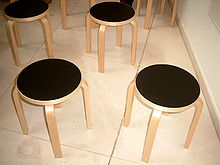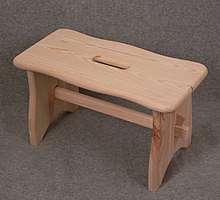stool


A stool (from Old High German [fuoʒ] scamil from late Latin scamillus " little bench" to Latin scamnum "bench") or stool is a simple piece of furniture without a backrest. The stool differs from a chair by the lack of arm and back rests . In the original sense, the stool corresponds to a footstool . There are variants with one, three, four or five legs. As a milking stool , they are one-legged and tied around the body with a strap.
Already known in antiquity , in the Middle Ages the stool was the most widespread seating furniture next to the bench , while the chair was mainly reserved for high-ranking people and the landlord and his wife until the 16th century. However, the actual origin of the stool is unknown. The English designer and collector Percy Macquoid suspects the introduction to Europe by the Vikings .
In the Middle Ages, the predominant seating furniture was benches, stools and very rare examples of throne-like chairs, which were considered status symbols. The stools of this period can be distinguished between a Gothic and a paneled form, a short bench with two paneled legs at the ends and the simple turned stool.
Four -legged, elaborately designed and upholstered stools, usually without armrests or backrests, have been known as taburett (French tabouret ) since the end of the 16th century . Some kingdoms and chiefdoms in Africa use stools instead of thrones. One of the most famous stools of this type is the golden chair of Asantehenes , about which a war between the British and the Ashanti Empire was fought in 1900. There are now many different types of stools that are valued as simple, cheap seating furniture. Simple variants come with the usual one to five legs or simple wooden blocks, but richly ornamented, covered and painted stools are also produced. The bar stool , for example, is particularly popular when it comes to furnishing bars .
In Austrian usage, stool is used more for low (e.g. milking stool), and stool for higher (e.g. bar stool) seating furniture without backrest.
See also
Web links
Individual evidence
- ^ Macquoid, Percy: A History of English Furniture . Studio Editions, 1988, ISBN 1-85170-080-3 , pp. 37 .
- ↑ Victor Chinnerey: Oak Furniture - The Brisitsh Tradition (1979), p. 261.
- ^ Meyers Konversations-Lexikon, 4th edition, Verlag des Bibliographisches Institut, Leipzig and Vienna 1890, Volume 15, p. 486.
- ^ Yaa Asantewaa Profiles .
- ↑ Victor Chinnerey: Oak Furniture - The Brisitsh Tradition (1979) 94th



